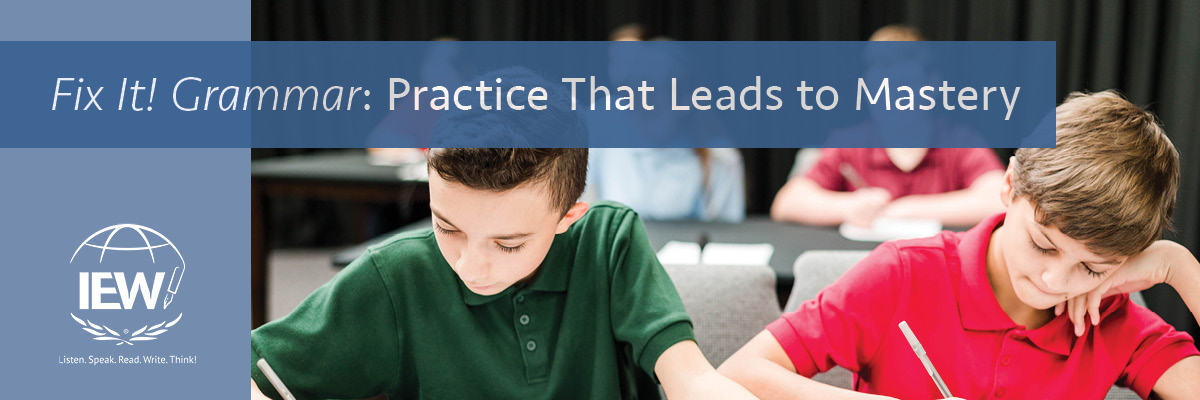
Practice, practice, practice. Mastery of any skill takes practice—lots of it. Musicians repeat scales and basketball players run drills. Until the skills have been practiced enough to gain muscle memory to perfect the task at hand, they sound and look awkward. Repetition leads to mastery. Teaching Fix It! Grammar in conjunction with the Structure and Style writing method provides opportunities for students to review, practice, and refine grammar concepts so they master them in their own writing.
Adding Fix It! Grammar to the writing instruction, where grammar is taught in context, gives students fifteen minutes a day to practice the skills they are learning in their writing course. Students are excited to complete their daily passage editing because learning the next detail of the story being presented captures their attention. The process gives them daily practice they need, but the story eliminates the boring experience of rote practice. The checklist of items to mark and errors to fix each day feels like a treasure hunt. Students enjoy checking items off the list as they find them.
The stories are filled with rich vocabulary enabling students to build lists of words they can use in their own assignments. Additionally, the complex sentence structures in Fix It! Grammar model for students how to combine ideas by adding phrases and clauses to their own simple sentences.
The pacing of Fix It! Grammar mirrors Structure and Style for Students. Stylistic techniques and their corresponding grammar rules are added one at a time, giving students time to practice before a new rule is added. The program is especially strong in reinforcing basic grammar rules by revisiting them often during the year and over the course of each subsequent year. As students move through the levels, they learn more complicated nuances to these rules suitable for their level. For example, in Level 1 Nose Tree, students learn that who/which clauses are set off with commas. When they reach Level 4 Mowgli and Shere Khan, they learn that essential who/which clauses do not require commas. Students who complete all six levels will gain sophisticated grammar knowledge.
Another strength is that the concepts are taught in context so the students’ comprehension of the rules increases. Rather than trying to apply the rules to arbitrary sentences, the cohesiveness of the sentences in relation to the story helps the students understand the “why.” When comprehension in context occurs, students are able to apply the grammar rules to their own writing. The editing process mirrors the writing process.
The program also provides resources for teachers to review concepts at the point of need for individual students or an entire class. When grading writing assignments, teachers make a list of common grammar errors students are making. Because the Scope and Sequence in each Fix It! Grammar book lists the weeks that a concept is introduced or reinforced, teachers can quickly guide students to a mini lesson to review that concept.
The Fix It! Grammar Glossary, provided in every Teacher’s Manual, is a useful resource with a full summary of grammar rules presented in the Fix It! Grammar program. The purchase of each Teacher’s Manual also entitles its owner to a download of the Fix It! Grammar Glossary to print for use in his or her own physical classroom. Each teacher must purchase his or her own Fix It! Grammar Teacher’s Manual.
A few months ago, I received a text message from the parent of a former student, telling me that his son had scored a 35 on the English portion of the ACT. The student had said his success was “thanks to Mrs. Pewthers,” but I know it was his exposure to the Structure and Style writing method and his completion of Fix It! Grammar in grades six through nine that led to his mastery of English grammar and writing.
|
Andrea Pewthers has thirteen years of experience teaching the IEW system in the middle school language arts classroom as well as serving as her school’s lead/mentor teacher. She was featured as IEW’s 2017 Teacher of the Year. After graduating with a BA in English from Oklahoma State University, Andrea worked in non-profit development positions in Texas and Oklahoma, writing grant proposals and marketing materials. Seeking to return to the workforce after a stint at home with young children, Andrea accepted a position teaching middle school English at a private school in Tulsa, Oklahoma. At the time, she remembers thinking, “I know how to write, but I don’t know how to teach someone to write.” A friend introduced Andrea to the IEW Teaching Writing: Structure and Style course. A live training with Andrew Pudewa solidified her understanding of the methodology. She loves that the curriculum allowed her to weave grammar, writing, and literature together into an efficient language arts classroom and looks forward to helping other teachers and schools do the same. |

